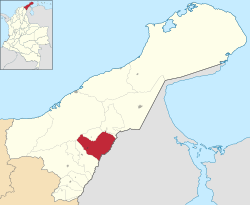Barrancas, La Guajira
| Barrancas | |||
|---|---|---|---|
| town | |||
| |||
 Location of the town and municipality of Barrancas in La Guajira Department. | |||
| Country | Colombia | ||
| Region | Caribbean | ||
| Department | La Guajira | ||
| Government | |||
| • Mayor | Juan Carlos Leon Solano (L)[1] | ||
| Area | |||
| • town | 1,060 km2 (410 sq mi) | ||
| • Urban | 742 km2 (286 sq mi) | ||
| Elevation | 40 m (130 ft) | ||
| Population (2005) | |||
| • town | 22,207 | ||
| [2] | |||
| Climate | Aw | ||
Barrancas is a town and municipality of the Colombian Department of La Guajira. The municipality of Barrancas is located to the left margin of the Ranchería River in a valley formed between the Sierra Nevada de Santa Marta mountains and the Serranía del Perijá. Barrancas has a total area of 742 km² and at 40 meters over sea level. The average temperature is 28°C throughout the year and distances from the capital of the Department of La Guajira, Riohacha. It became a municipality in 1892.[3]
Its economy is based on agriculture and coal mining which is exploited by the Cerrejón coal mine.[3]
Geography
Barrancas is located in the Guajira Peninsula in the Caribbean Region of Colombia, limiting to the east with the Bolivarian Republic of Venezuela; to the north with the municipalities of Hatonuevo and Albania; to the south with the municipality of Fonseca and to the west with the municipality of Riohacha. The municipality covers a total are of 742 km² (286.5 sq mi) and is some 40 m (131 ft) over the sea level.
The municipality of Barrancas lies in the Valley of Upar formed between the Sierra Nevada de Santa Marta (west) and the Serranía del Perijá (east) and within the basin of the Ranchería River.
Climate
The climate present in the region is predominantly hot and dry with no mountainous climate variations, maintaining an average temperature throughout the year of 28°C; while in the lower plains temperature can reach 35°C, while in the mountainous area of the municipality the temperature is milder. During the rainy season temperature in the mountainous part of the municipality can reach between 15-18°C while in the dry season 18-24°C. Higher temperature are reached by the end of March, April and May In June and July temperatures drop and in August and September raises. In October and November drops once again and raises in December and January due to the trade winds.[4]
History
During the war of independence from Spain, on March 26, 1813 the Cabildo of Barrancas insurrected against the local Spanish monarchy authorities destroying images and coat of arms of King Fernando VII. The cabildo also swore loyalty to Simón Bolívar. The revolt was led by Eugenio Vidal, Javier López Sierra, Jose Rodriguez Romero, Misael Orozco, Pedro Ojeda, Crisanto Solano, Bienvenido Gomez and Pedro Miguel Garavito.[5]
Barrancas was one of the villages part of the Province of Padilla and became a municipality in 1892.[6] It was also one of the five municipalities that grouped to form the Department of La Guajira in 1954, then called Intendencia Nacional de La Guajira by orders of then military dictator Gustavo Rojas Pinilla.[7]
Politics
Demographics
According to projections made by the DANE for the year 2005 the municipality of Barrancas had a population of approximately 29,856 inhabitants.[8]
| Year | Population total |
|---|---|
| 2002 | 27,519 |
| 2003 | 28,285 |
| 2004 | 29,064 |
| 2005 | 29,856 |
Economy

The municipality of Barrancas is connected through a highway to the department capital, Riohacha and the main commercial town in the department, Maicao. Barrancas also has cultural influence and commercial trade related to agriculture from the city of Valledupar in the Department of Cesar. Barrancas commercializes in small scale agricultural products such as coffee, plantain, cotton, maize and yuca, but the main economic activity in the municipality is the exploitation of coal at Cerrejón coal mine. The Cerrejón coal mine is one of the largest open pit coal mine in the world.[9]
Culture
The municipality celebrates the Festival y Reinado Nacional del Carbón (Coal National festival and Pageant) in October.[10]
Notes
- ↑ (Spanish) Colombian Registry of the Civil State: 2007 election results
- ↑ (Spanish) Observatorio del Caribe Colombiano: Grupo Regional de investigación en economía y competitividad en el Caribe colombiano by Weildler Guerra, Paola Quintero, Jorge Quintero and Ana María Maldonado
- 1 2 (Spanish) Gobernacion de La Guajira - Barrancas Archived August 13, 2007, at the Wayback Machine.
- ↑ (Spanish) Galeon.com: Barrancas - Climate
- ↑ Castro Trespalacios 1979, p. 85
- ↑ (Spanish) Barrancas: Foundation date Archived August 13, 2007, at the Wayback Machine.
- ↑ (Spanish) Galeon.com: Barrancas - History
- ↑ (Spanish) Galeon.com: Barrancas - Population
- ↑ (Spanish) Barrancas: Economy
- ↑ (Spanish) National System for Cultural Information: Festival y Reinado Nacional del Carbón
References
- Castro Trespalacios, Pedro (1979), Culturas Aborigenes Cesarences e Independencia de Valle de Upar, Bogotá: Casa de la Cultura de Valledupar
External links
Coordinates: 11°00′N 72°45′W / 11.000°N 72.750°W
.svg.png)
